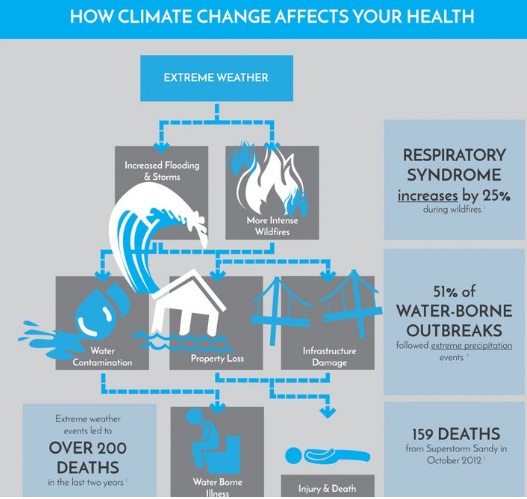(HOT) UPSC Current Affairs 2025 PDF
NEW! The Gist (NOV-2025) | E-BOOKS
Extreme Weather and Health Hazards : Important Topics for UPSC Exams

Extreme Weather and Health Hazards--
Extreme weather events increases with the climate change phenomena. These extreme weathers are hazardous for the health of people. With climate change, the occurrence of natural disaster increases around the world. These disasters include, not only the disasters related to water, but also earthquake, pandemic etc.
The extreme weather events fall into three categories—high precipitation disaster, low precipitation disaster, and sea level rise disaster.
- High Precipitation disaster- The events like storm, floods and landslide can be disastrous and kill population on a mass scale.

Source-- climatenexus ALPHA
The above average rainfall effects on health--
| Event | Type | Description | Potential Health Impact |
| Heavy precipitation | Meteorological | Extreme Event | Increase mosquito abundance. |
| Flood | Hydrological | River/streams overtop its banks | Mosquitoes and surface water contamination |
| Flood | Social | Property and crop damage | Change in mosquitos' abundance and contamination of water with fecal materials and rat urine. |
| Flood | Catastrophic flood or disaster | Flood on big scale that may lead to govt call or external assistance. | Larger health impacts due to mosquitoes, contaminated diseases and pandemic diseases. |
- Low Precipitation disaster—It includes heat waves, drought and wildfire. There is severe health risk associated with heat waves. Extreme heat possesses a problem because it disrupts the body's natural abilities to regulate its temperature. In extreme heat, body would not be able to get rid of enough heat, so that the body temperature rises. This may lead to conditions like heat stroke.
The extreme heat also increases the risk of death from heart diseases, respiratory diseases, kidney diseases and other illness.
The below average rainfall effect on health--
| Event | Type | Description | Potential Health Impact |
| Drought | meteorological | Soil moisture decreases as evaporation exceeds water absorption | Change in vector abundance |
| Drought | agricultural | Drier than normal conditions leading to decreased crop production | Depends on socio-economic factors of the land. |
| Drought |
social | Reduction in food supply or income, reduction in water supply and quality | Food shortages, illness, malnutrition etc. |
| Drought | Food shortage/ famine/ drought/ disaster | Food shortage leading to deaths | Severe health impacts lead to population displacement |
- Sea-level rise disaster—The rise in sea level causes severe health hazards for the coastal communities. It is estimated that nearly 40% of the world population live 100 km around the sea coast. Any big natural disaster associated with rise in sea level can become havoc for this large population live near the coast.
- Not only sea-level rise, but oceanic acidification is also causing severe problems to the health. The health of ocean has a direct effect on the health of humans. Human relies heavily on oceans for food, nutrition, employment, weather pattern and transportation. Therefore, any impact of extreme weather over the ocean would have direct effect on human survival.
Buy Printed Study Material for UPSC Pre General Studies (Paper-1)
Online Crash Course for UPSC PRE Exam
Way forward--
- Climate change can be mitigated by addressing these issue by
multidisciplinary approach that works at global, national and community
level. Climate is an important determinant of human health. Therefore, it is
required to research and understand the effect of changing weather and
climate upon human health. Table below shows priority health research areas
for different risk factors resulting from climate change--
| Risk factors | Health effects | Priority research areas |
| Extreme heat or cold; stagnant airmasses | Temperature related illness and death. | Improved prediction, warning and response |
| Strong precipitation and variability | Extreme weather-related health effects | Assessment of past impacts and effectiveness of the warning. |
| Local air pollution, stagnant air masses | Air pollution related health effects | Combined effects of climate factors and air pollution; weather related allergens. |
| Precipitation, water temperature, temperature, humidity,
precipitation, water scarcity, land use, extreme events, population
displacement |
Water borne and food-borne diseases Vector borne and rodent borne
diseases Nutritional deficiencies Mental Health |
Climate and marine related diseases Climate, land-use impacts on water quality and health Climate related disease transmission dynamics; improved surveillance Health and agricultural sector adaptation strategies Assessment of past interventions related to emergencies and population displacement. |
As climate change processes already are underway, efforts also must focus on assessing current and future vulnerabilities and identifying necessary interventions or adaptation options. Adaptation has the potential to reduce adverse effects of climate change but is not expected to prevent all damages. Therefore, early planning for health is essential to reduce, hopefully avoid, near future and longer-term health impacts of global climate change. The optimal solution, however, is in the hands of governments, society and every individual—a commitment for a change in values to enable a full transition to sustainable development.
MODEL QUESTIONS
Q. Which of the following is/are correct regarding United Nations Framework Convention on Climate Change (UNFCCC)--
- It is one of the outcomes of Earth summit held in 1992.
- UNFCCC is itself legally binding but Kyoto Protocol is not legally binding at all.
- The COP 23 of UNFCCC was held in Bonn, Germany.
(1) Only I
(2) Only I, III
(3) Only I and II
(4) Only I, II, III
Hint—Answer (2). UNFCCC itself is non-legally binding. However, its Kyoto protocol is a legally binding.
Essay—Climate Change and its hazardous effect over the health.
Hint—Write by yourself.

